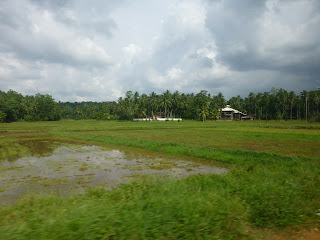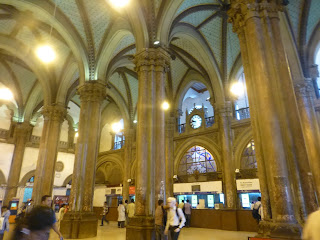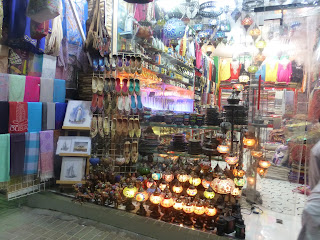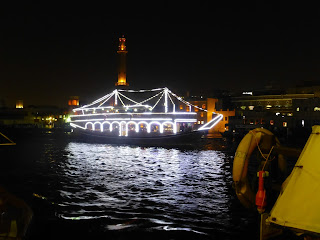The next day, the port of call was Port Klang, which is the port for Kuala Lumpur, Malaysia.
Again, we elected to stay on the ship and in the port. It was quite a distance to get to Kuala Lumpur, we have been there before on a land trip, and there is real difficulty getting there without going on a ship's tour. There is a "taxi mafia" here, which charges exorbitant rates to either get to KL or get to the local transportation system to go there. We went into the terminal to do some internet, and we also saw lots of the crew going off in order to eat at a couple of local places which had set up outside the terminal. The waters were very calm and we got a great picture:
The next day we docked at Phuket, Thailand. I had tried to book a private tour guide but was unsuccessful. David, Diane, Elaine and I took the tender into the port and found that there was really no terminal there with any tourist information. We were immediately assaulted by a bunch of guys who wanted us to hire them to take us around the island or into town. We walked a bit, but it was really hot, and it became obvious that we needed transportation to get into town. One of the guys had followed us and offered a price that was more acceptable, so we had him take us into the main part of town. There were a lot of what they call "shop houses", where there is a business or shop on the street level and the family lives upstairs. Here is a picture:
There was also a sizable Chinatown which we drove through:
After walking around a bit, we found a cafe where they had decent internet and local beer so we stopped for some refreshment:
Back on board, one of the perks we get for being frequent cruisers is 2 for 1 dinners in the specialty restaurants. So on formal night we had dinner at Chops with Vicki and Randy, and David & Diane:
Prior to the dinner, we had drinks with the friends, commonly called the 5 o'clock Drinking Club, and then we all went to the professional photographers and had a group picture:
On May 8 our port of call was Colombo, Sri Lanka. Since this was a place we had never been to before, I had arranged a private tour guide, Ishan. He was there when our ship docked to pick us up. On this trip we were joined by Mark, and Alice & Bruce. Here is the whole gang:
When you hire a local guide, you can arrange your whole day of sightseeing. Besides a city tour, Ishan suggested taking us to the Pinnawala Elephant Orphanage, so that is where we went first. Pinnewala Elephant Orphanage is an orphanage, nursery, and captive breeding ground for wild Asian elephants. What we didn't realize was that it was quite a distance to get there over roads which were rather busy, and he wanted to get us there in time to see the elephants while they were in the river, and before they walked them back to the reserve. So we had a very wild ride through the countryside. It was interesting to see the topography and the houses of the locals:
Typical local products were for sale along the road. There were lots of stands selling coconuts:
There were also stands where locals were selling things they have woven from local plants, and here there is a guy carving furniture from local wood:
We arrived at the Pinnawala Elephant Orphanage in time to see quite a few of the elephants in the river:
Here we are with the elephants in the background:
Ishan arranged for us to go up to a viewing platform of a restaurant overlooking the river. We also had a very tasty and inexpensive lunch up there with really good, cold local beer.
While we were in the restaurant, the elephants were taken out of the river and walked up the street to the actual elephant reserve, which was across the main road:
After lunch we walked over to the actual elephant reserve. Pinnawala is notable for having the largest herd of captive elephants in the world. On the other side of the road there were pens for the smaller elephants, where they were brought in for bottle feeding in front of the tourists. The fees to enter the reserve are used to pay for the elephants care, and people can pay extra in order to bottle feed the babies:
Additionally, for a small fee, people can purchase small pieces of sugar cane to feed to the adolescent elephants. Here is Elaine, feeding sugar cane to a teenage elephant:
There are close to 90 elephants at this reserve now, although 25 years ago they started with 5 orphans. On the drive back to Colombo we observed the countryside, which was very tropical and lush:
In Colombo, Ishan did his best to show us all the important sites. He took us to a big park where there were Sri Lankan deer in an enclosure:
Also at this park were some interesting paintings on the street pavement. Here is one designed to look like we are at the top of a waterfall:
While we were walking around the park, this reptile decided to climb out of the creek to greet us:
The park also had a very nice garden section, and a building with many aquarium windows with lots of Sri Lankan fish displays. Here is one of them:
Ishan continued to drive us around Colombo, and we were very impressed with the cosmopolitan nature of this city. This was one of the public buildings in a park:
Here is one of the statues in Viharamahadevi Park:
Ishan also drove us through the Galle Face neighborhood, where there are very upscale shopping venues, big and expensive hotels, and a nice beach area. We couldn't take any pictures because it was starting to get dark, but it was definitely an area where we would have liked to spend a little more time.
Back on the ship, we enjoyed spending time in the Diamond Lounge with the 5 o'clock drinking club, because although some of the friends had left, more friends from previous cruises had joined the group:
This is Vicki & Randy Sheppard, Sandra and Pat, Glenn & Evelyn, and Tom & Sandy Wills. All were onboard with us for this cruise and the next one.
The next port, on May 10, was Cochin, India. This is a place in southern India where we had spent several days on a land tour in 2010. The port was not close to the town, and we had already seen most of the tourist attractions, so we elected to stay on the ship. Cochin is famous for having Chinese fishing nets along the shoreline. These are fixed shore installations of huge fishing nets (20 meters or so across), which use counterweights on ropes suspended from poles to help lower the nets. It takes up to 6 fishermen to operate these contraptions. Nowadays they are mostly tourist attractions. Here is a picture Vicki took of them:
There were also a lot of typical hauling trucks in the port area:
On May 11, there was a Top Tier party on the ship, and we were the main attraction because we achieved Pinnacle status. This is the highest level cruisers can attain on Royal Caribbean for being loyal cruisers - we had to have 700 cruise nights on Royal Caribbean. The award was presented by the loyalty ambassador, the Next Cruise Manager, and the Captain:
Then we asked that all our friends from the 5 o'clock drinking club in the Diamond Lounge come up on stage with us, and the photographer took a picture:
There are some extra perks one achieves for this status, and one of them is that we get to have gold cards, which are usually issued only to people who book suites.
Later on in the cruise, David & Diane had a party for us in their suite. Here is a picture of the friends who attended:
It was really special that so many of our friends were on board with us to help us celebrate this milestone - especially Diane and David, who have been on many cruises with us and who hosted this party for us.
On May 13 we had a full day to explore Mumbai, a place we had never been before. I had arranged for a private guide who picked us up outside the port gate. David & Diane, and Vicki & Randy went with us. Mumbai is actually built on 7 islands which are now interconnected. It is also the home of the 4th largest populace in the world. It was an adventure just driving through the streets. First our guide, Mohammed, took us to the Gateway of India. The Gateway of India was built in 1924 to celebrate the arrival of King George V and Queen Mary. It took 13 years to build. It stands on the shores of the Arabian Sea.
Nearby, and within walking distance, was the Taj Mahal Palace Hotel. It is a 5 star hotel, with 560 rooms, 44 suites, and 1500 employees. The doors were first opened in 1903. Legend has it that Tata, the owner, built the hotel because he was refused entry at Mumbai's best hotel, Watson's Hotel, because he was not white. Now Watson's Hotel has fallen into disrepair and The Taj Mahal is the finest hotel in India. In 2008 the hotel was attacked by terrorists and in the ensuing siege, 167 people were killed. The hotel was repaired and reopened within a few months.
At one of the entrances, we saw this doorman:
We walked through the hotel, which is very richly decorated. This is a picture of the lobby:
There were nice displays of pictures of people who have stayed there at various times, including Hillary Clinton who stayed in 2009, after the terrorist attacks, as a show of support and solidarity for India.
Walking down a nearby street, we passed several street carts, such as this one, selling sugar cane and cane juice:
It was also surprising to see this ox cart driving right down a busy street in the downtown area:
One of the most impressive buildings from the British Occupation is the main railway terminal building which was built in 1887. It is a UNESCO World Heritage site. It is built in the Victorian Gothic style and has 18 platforms. It is the busiest train station in India, and was really buzzing with people when we walked through it. It was also attacked by terrorists with AK-47's in Nov. 2008 and 58 people were killed and 104 injured.
This is a picture of the inside of one of the ticket lobbies:
Our next stop was the Mani Bhavan Gandhi Museum, which is located not very far from Chowpatty Beach. It used to be the focal point of Gandhi's political activities between 1917 and 1934. It was acquired and dedicated as a memorial to Gandhi in 1955, and other than Martin Luther King, the only high-profile international visitor has been President Baack Obama. There are many interesting exhibits and dioramas about Gandhi's life and his philosophies. This is the outside:
On one of the wall's was this quote from him: "To call women the weaker sex is a libel; it is man's injustice to woman. If by strength is meant moral power then woman is immeasurably man's superior. If nonviolence is the law of our being, the future is with women." I love it!
One of the most interesting places we stopped was at a roadway overpass where we could overlook the Dhobi Ghat, which is a huge open laundry. Here is a picture of it:
There are rows of open-air concrete wash pens, each fitted with its own flogging stone:
The clothes are collected from places of business and homes by a guy called a Dhobi. They are washed and hung on lines all over the laundry and no clothes pins are used to hang them:
Once dry, the clean clothes are folded and returned to the place where they were collected. It is amazing!
Another amazing thing was seeing people who perhaps are living on the streets, or perhaps just resting, sleeping right on a busy street full of traffic and noise:
It was hot and we had been touring around for a while, so we stopped at a small cafe where we had local beer:
Mohammed took us across a bridge over to an upscale neighborhood, then a park where we walked around and also enjoyed some water views across to another part of the city. The bridge was quite modern:
Dharavi is a locality which houses the largest slum in India, and possibly the largest in the world. It was founded in 1882s during the British colonial era. The slum grew in part because of an expulsion of factories and residents from peninsular city center by colonial government, and from rural poor migrating into urban Mumbai. Dharavi has an active informal economy in which numerous household enterprises employ many of the slum residents. It exports goods around the world.
It covers an area of about 535 acres and houses between 300,000 to 1 million people. It is composed of about 60% Hindus, 30% Muslim, and the rest are mixed.
There were lots of guys pushing really overloaded carts along the street - I suppose they were hauling goods to the market.
There were stores all along this street as well. We returned to the port and the ship, and had a fairly impressive sunset:
There were several sea days before the cruise ended in Dubai. One of the perks we get for being Diamond+ or Pinnacle is the offer to do a bridge tour, theater tour, and galley tour. This time we did the bridge tour. The bridge is a lot more spacious than you would think. And it is interesting to see all the technological controls they use nowadays. Here is Capt. Gustavo on the bridge:
On May 16 we arrived in Dubai, which was the end of this cruise segment. Unfortunately, Dubai had very bad air quality and the picture I took of the city view from the ship isn't very good because of that.
It was about 114F degrees during the day, and surprisingly, there was humidity, so it seemed even hotter. David, Diane, Elaine and I had all been in Dubai before - we spent 3 days there at the end of a cruise several years ago and did a very complete job of seeing the main sights. In the above picture, you can just make out the Burj Kahlifa, which is the world's tallest building. Good thing we went to the top viewing platform the last time because the visibility wouldn't have been good on this day. There was supposed to be a free shuttle to one of the malls, so we decided to go, but it wasn't running, and it was so hot out we decided to stay on the ship, and go out in the evening. It wasn't much cooler later on, but we took a taxi to the Creek, and then rode across the creek on the local small boats, called abras. The fare across is less than a dollar.
The shops were open and people were out shopping.
Last time we enjoyed walking through the Gold Souk so we headed there. Nowadays the souk area mostly has stores selling gold jewelry, not stalls. Some of the gold items are very unique, and all are pricey.
On the way back across the creek, we saw some of the dinner and party boats all lit up:
The next day some of the people got off the ship, and we got more cruisers to replace them.






























































No comments:
Post a Comment